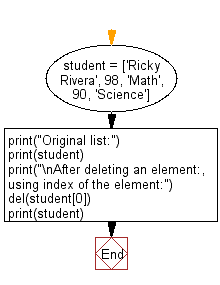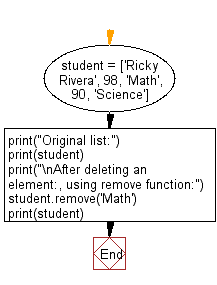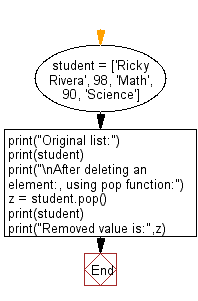Python: Remove an element from a given list
Python List: Exercise - 211 with Solution
Write a Python program to remove an element from a given list.
Sample Solution-1:
Python Code:
student = ['Ricky Rivera', 98, 'Math', 90, 'Science']
print("Original list:")
print(student)
print("\nAfter deleting an element:, using index of the element:")
del(student[0])
print(student)
Sample Output:
Original list: ['Ricky Rivera', 98, 'Math', 90, 'Science'] After deleting an element:, using index of the element: [98, 'Math', 90, 'Science']
Flowchart:

Visualize Python code execution:
The following tool visualize what the computer is doing step-by-step as it executes the said program:
Sample Solution-2:
Python Code:
student = ['Ricky Rivera', 98, 'Math', 90, 'Science']
print("Original list:")
print(student)
print("\nAfter deleting an element:, using remove function:")
student.remove('Math')
print(student)
Sample Output:
Original list: ['Ricky Rivera', 98, 'Math', 90, 'Science'] After deleting an element:, using remove function: ['Ricky Rivera', 98, 90, 'Science']
Flowchart:

Visualize Python code execution:
The following tool visualize what the computer is doing step-by-step as it executes the said program:
Sample Solution-3:
Python Code:
student = ['Ricky Rivera', 98, 'Math', 90, 'Science']
print("Original list:")
print(student)
print("\nAfter deleting an element:, using pop function:")
z = student.pop()
print(student)
print("Removed value is:",z)
Sample Output:
Original list: ['Ricky Rivera', 98, 'Math', 90, 'Science'] After deleting an element:, using pop function: ['Ricky Rivera', 98, 'Math', 90] Removed value is: Science
Flowchart:

Visualize Python code execution:
The following tool visualize what the computer is doing step-by-step as it executes the said program:
Python Code Editor:
Have another way to solve this solution? Contribute your code (and comments) through Disqus.
Previous: Write a Python program to compute the sum of non-zero groups (separated by zeros) of a given list of numbers.
Next: Write a Python program to remove all the values except integer values from a given array of mixed values.
What is the difficulty level of this exercise?
Test your Programming skills with w3resource's quiz.
Python: Tips of the Day
Find current directory and file's directory:
To get the full path to the directory a Python file is contained in, write this in that file:
import os dir_path = os.path.dirname(os.path.realpath(__file__))
(Note that the incantation above won't work if you've already used os.chdir() to change your current working directory, since the value of the __file__ constant is relative to the current working directory and is not changed by an os.chdir() call.)
To get the current working directory use
import os cwd = os.getcwd()
Documentation references for the modules, constants and functions used above:
- The os and os.path modules.
- The __file__ constant
- os.path.realpath(path) (returns "the canonical path of the specified filename, eliminating any symbolic links encountered in the path")
- os.path.dirname(path) (returns "the directory name of pathname path")
- os.getcwd() (returns "a string representing the current working directory")
- os.chdir(path) ("change the current working directory to path")
Ref: https://bit.ly/3fy0R6m
- New Content published on w3resource:
- HTML-CSS Practical: Exercises, Practice, Solution
- Java Regular Expression: Exercises, Practice, Solution
- Scala Programming Exercises, Practice, Solution
- Python Itertools exercises
- Python Numpy exercises
- Python GeoPy Package exercises
- Python Pandas exercises
- Python nltk exercises
- Python BeautifulSoup exercises
- Form Template
- Composer - PHP Package Manager
- PHPUnit - PHP Testing
- Laravel - PHP Framework
- Angular - JavaScript Framework
- Vue - JavaScript Framework
- Jest - JavaScript Testing Framework
